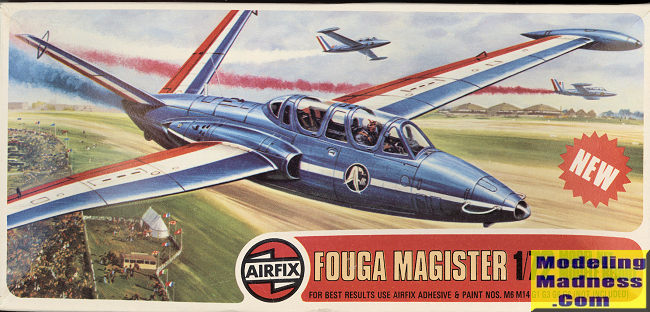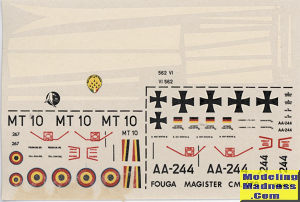
Airfix 1/72 Fouga Magister
| KIT #: | 02047 |
| PRICE: | $1.50 |
| DECALS: | Three options |
| REVIEWER: | Scott Van Aken |
| NOTES: | 1975 initial release |

| HISTORY |
The Fouga CM.170 Magister is a 1950s French two-seat jet trainer aircraft, developed and manufactured by French aircraft manufacturer Fouga. Due to industrial mergers, the aircraft has been variously known as the Fouga CM.170 Magister, Potez (Fouga) CM.170 Magister, Sud Aviation (Fouga) CM.170 Magister and Aérospatiale (Fouga) CM.170 Magister, depending on where and when they were built.
In 1948, development commenced at Fouga on a new primary trainer aircraft design that harnessed newly developed jet propulsion technology. The initial design was evaluated by the French Air Force (Armée de l'Air, AdA) and, in response to its determination that the aircraft lacked sufficient power for its requirements, was enlarged and adopted a pair of Turbomeca Marboré turbojet engines. First flying on 23 July 1952, the first production order for the type was received on 13 January 1954. Export orders for the Magister were received, which included arrangements to produce the type under license in West Germany, Finland and Israel. In addition, the related CM.175 Zéphyr was a carrier-capable version developed and produced for the French Navy.
While primarily operated as a trainer aircraft, the Magister was also frequently used in combat as a close air support platform by various operators. In the latter capacity, it saw action during the Six-Day War, the Salvadoran Civil War, the Western Sahara War, and the Congo Crisis. In French service, the Magister was eventually replaced by the Dassault/Dornier Alpha Jet. After its retirement by the French Air Force, Magisters were purchased by several private-owner pilots in the US and have since been operated in the experimental category.
| THE KIT |
So far, there have been four 1/72 Magisters of which I am aware. The most recent was by Special Hobby and prior to that was one from Valom, which is as much a short run kit as a standard mass produced version. The other two are from Heller and Airfix, both from the 1970s. Both of these latter kits are of the raised panel line type and while I have not yet built the Airfix kit, I found the Heller one to be a decent build.
The airfix kit has a tub cockpit with raised instrument panels. There are no separate seats with those spaces to be filled with crew members. There is a control stick for each position. Two piece blanking plates are installed into each fuselage half for the intakes and exhaust. If doing the French version, you need to open holes in the nose for the antennas that are there.
Wings are upper and lower halves for each side and there
is gear well detailing. The upper wing includes the flaps and ailerons along
with the upper wing tank halves. The v-tails slot in place and you need to add
some external elevon hinges. The canopy is a single piece with the Belgian and
German versions needing the rear
 seat
periscope installed. Landing gear is well done and you have the option to do a
gear up aircraft. A display stand is included for this. Finally, there are a lot
of scopps that fit to the fuselage.
seat
periscope installed. Landing gear is well done and you have the option to do a
gear up aircraft. A display stand is included for this. Finally, there are a lot
of scopps that fit to the fuselage.
Instructions are well done with three options. One is the box art plane and that will need some careful painting, though the white bits are on the decals. The other are both in silver/bare metal. The Belgian option has da-glo nose, fuselage, and wing tips. The German version does not. The decals look like they are still in good shape, but I'd have aftermarket ready just in case.
| CONCLUSIONS |
This should make into a nice model for your shelf. There are aftermarket decals out there if you don't want to use the ones with the kit. I notice that no nose weight was indicated and it may well be that none is required. Besides, there isn't a lot of room for it.
| REFERENCES |
https://en.wikipedia.org/wiki/Fouga_CM.170_Magister
May 2021 Copyright ModelingMadness.com. All rights
reserved. No reproduction without express permission. If you would like your product reviewed fairly and fairly quickly, please contact the editor or see other details in the
Note to
Contributors.